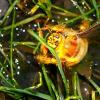Hello everyone,
I am new the the any keeping game and excited to post for the first time. I have wanted a "real" ant farm since I was a kid. This summer I caught three queen carpenter ants in northern Vermont. (I am not sure exactly what genus they are Camponotus mysterious). I have had them in test tube setups since then (about 2 months) and last week, lo and behold, one had hatched! Now, I have four workers with a 5th expected soon. I put together what I thought was a smart way to get them to move to a new, better nest. I put the opening to the new nest up against the test tube opening. So now the new nest is between the ants and their out world. I figured the workers would be forced to check out the new nest on their way to the food in the out world and decided to upgrade their living accommodations. (I have attached an image.) However, the baby workers (callows) seem to have very little interest in exploring outside of the test tube setup. The queen went in once (to my knowledge but apparently was not impressed and has not been back since.) It was is my understanding they should be out there looking for food etc. So....should I just wait? Will they begin to explore? Or should I take more drastic measures? I don't want them to starve, but I don't want to bother them either. On the other hand the queen seems little less active than she has been and I am a little worried about her.
Any insight on this matter would be much appreciated.
Thanks very much!

















